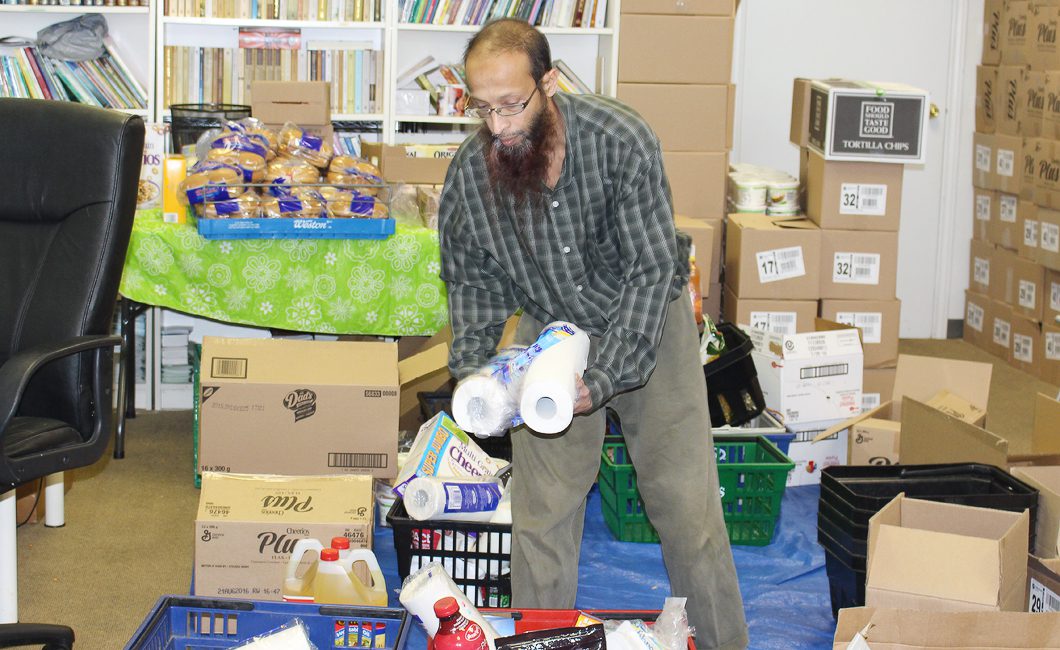The crowd inside the small office of Thorncliffe food bank is nearly outside the door as it opens for service on Thursday. Zeeshan Modi, food bank co-ordinator, works to put together baskets of food to give to the waiting families — food that they can pick up once a month, but only lasts them a week at most.
Toronto continues to be the capital of child poverty in Canada with 27 per cent of all children living in poverty, according to a report released on Nov. 14.
“Children who grow up in poverty lack the opportunity to be creative, to think outside the box, and to be able to dream big; to dream of a better life for themselves.”
—Nawal Al-Busaidi
The report, called “Divided City: Life in Canada’s Child Poverty Capital,” was compiled by Family Service Toronto, Social Planning Toronto, the Children’s Aid Society of Toronto and Colour of Poverty-Colour of Change. The social agencies examined child poverty in 140 neighbourhoods and found that Toronto is a “deeply divided city” in terms of living conditions and opportunities for children.
“When you cross Laird Avenue to go from Leaside to Thorncliffe, the rate of child poverty rate increases from four to 52 per cent,” said Jessica Mustachi of Family Service Toronto in a media release.
Modi sees over 1,000 food bank visitors every month and gives them equal amounts of donated food such as cereal, pasta, oil and juices, but it’s not nearly enough.
He cited unemployment, low income, the increasing cost of food and an abundance of newcomers in Thorncliffe Park as key reasons for the high rate of child poverty.
“There are very skilled immigrants who come into Canada and language is an issue, cultural integration is an issue and the employer expectation could also be a barrier to access meaningful employment,” said Nawal Al-Busaidi, manager of family support services at the Thorncliffe Neighbourhood Office.
Seema Naeen experienced these issues firsthand when she came to Canada five years ago from Pakistan with her two-year-old son.
“We didn’t have anything,” Naeen said. “My husband did his Masters in London and he was a marketing head in Pakistan, but when he came to Canada he started working in the call centre.”
This situation is compounded by the fact that family dynamics in Thorncliffe Park demand at least a moderate income level.
“Thorncliffe has four to five children in each household, compared to Leaside, which is between two to three,” Al-Busaidi said.

Percentage of Grade 3 students in 2014 below provincial standard in math, reading, and writing by income quartile. (Divided City: Life in Canada’s Child Poverty Capital, Education Quality and Accountability Office (EQAO), Grade 3 and Grade 6 Assessments, 2013/2014)
Early learning and recreational participation levels of Toronto children are dependent on family income, according to the report. Half of the children with a household income below $30,000 do not participate regularly in extracurricular arts or sports, compared to just seven per cent in families with incomes over $100,000. Such disparity has long-term effects on children’s development.
“Children who grow up in poverty lack the opportunity to be creative, to think outside the box, and to be able to dream big; to dream of a better life for themselves,” Al-Busaidi said.
“We have large number of youths who get engaged in crime and illegal activities to gain quick cash, and that comes out of devastation; it comes out of lack of resources and lack of opportunities.”
Children suffer not only physically and mentally in these living conditions, but also emotionally, said Naeen, whose sons are now aged seven and three. “They don’t know what’s going on or what their parents are dealing with. All they know is that they’re a kid and they want their toys, but their parents aren’t giving it to them.”
“I was depressed, my husband was depressed, and of course that affects the children too. When you’re happy, your kids are happy; when you’re tense, your kids are tense.”
The community of East York is doing a lot to support its less affluent neighbourhoods such as Thorncliffe Park. Al-Busaidi said Leaside has been a great neighbour.
“They’ve been there for the community through the holidays, through the times of need and they’ve really stepped up in their support to show neighbourly compassion.”
But she stressed that poverty is a systematic issue, and no single community can help another become financially comfortable.

Sarah Terrill works in the lobby of Thorncliffe Neighborhood Office, which offers various programs to help children and families. (Cherry Liu/Toronto Observer)
All levels of government have a responsibility to reduce poverty, and the report called for immediate action from the city.
“Now is not the time to reduce services or raise fees for already unaffordable or inaccessible housing, transit and child care,” the report said. “Rather, now is the time to move forward with fair and equitable taxation measures to fund the investments in affordable housing, transit, child care and recreation to ensure that every child has the chance to succeed.”




